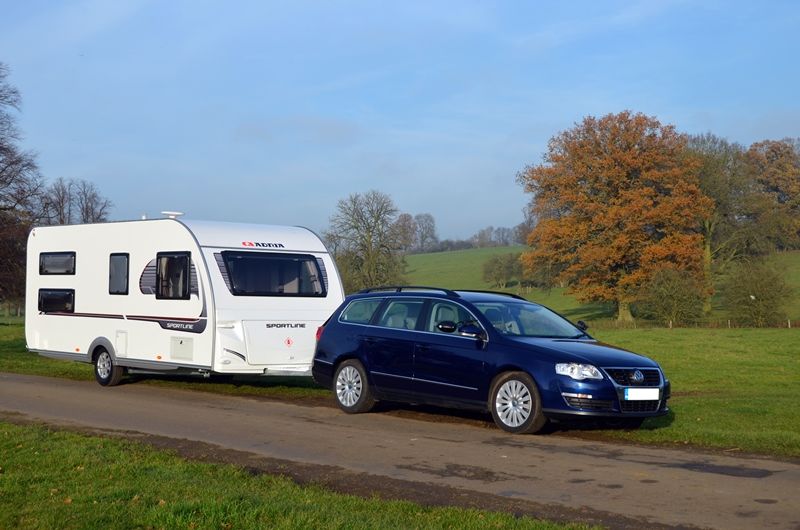
It is important to understand your driving licence entitlements to ensure you remain legal. The standard UK driving licence allows most people to tow a caravan or drive a motorhome, but there are a few exceptions.
If you are reaching 70, want to drive motorhome heavier than 3,500kg or have a driving licence issued in Northern Ireland, for example, you may find your options being limited. This Data Sheet helps guide you through the regulations included the changes from 16 December 2021.
Further sections explain the jargon used in licensing terms and other general principles you need to know to remain legal when towing or driving motorhomes. Please note, for ease we refer to trailers throughout instead of listing caravans, trailers, trailer tents and folding campers.
Driving licences are controlled and issued by the Driver and Vehicle Licensing Agency, commonly known as DVLA.
Since 2014 the responsibility for overseeing the driving test (both theory and practical) lies with the Driving and Vehicle Standards Agency (DVSA), before then it was looked after by the Driving Standards Agency (DSA). Both DVLA and DVSA provide information on-line through the gov.uk website. They often use terms which you need to understand to appreciate the limitations of your licence, hence the jargon panel below.
DVLA Jargon
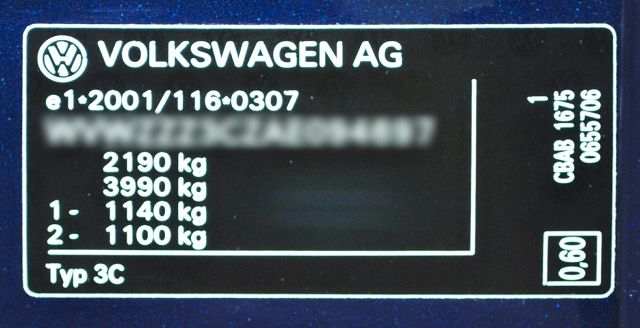
Vehicle Identification Number (VIN) Sticker showing GVM/MAM is 2190Kg, next is GTW at 3990kg and the two numbers below refer to individual limits for each axle
The words ‘weight’ and ‘mass’ are considered interchangeable in DVLA and vehicle manufacturer documentation. They are normally quoted in kilogrammes (kg) or tonnes (t), where 1,000kg is one tonne.
Here are some other terms you may come across when considering the practicalities of towing.
Maximum Authorised Mass (MAM) means the maximum total weight that a vehicle or trailer is designed to carry. It is set by the vehicle's manufacturer and includes the vehicle weight and the maximum load it can carry.
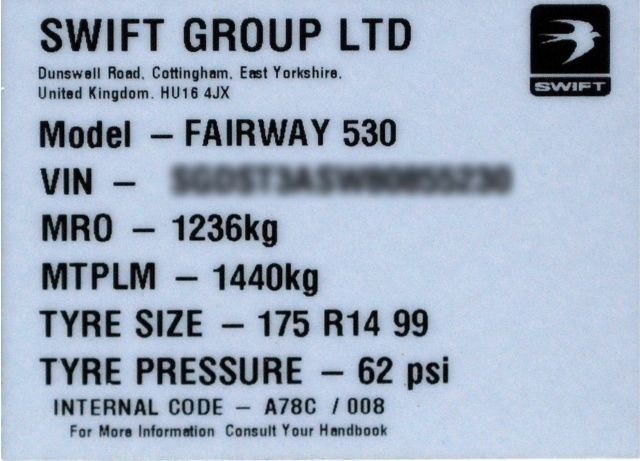
Caravan weight sticker/plate showing MTPLM
Equivalent terms: Gross Vehicle Weight (GVW), Maximum Permissible Weight (MPW), Maximum Gross Weight (MGW) and Maximum Technical Permissible Mass (MTPLM)
Gross Train Weight (GTW) is the maximum weight a vehicle can move on the road as stated by the manufacturer. It includes the vehicle's own maximum loaded weight (MAM) and the weight of a trailer and load. Sometimes referred to as Gross Train Mass (GTM)
Unladen Weight (ULW) is the weight of the vehicle when it's not carrying any passengers, goods or other items. It includes the vehicle body and all parts normally used by the vehicle when in use on the road, but doesn't include the weight of fuel.
Kerbweight as defined in a European Directive and as most commonly used, is the weight of the vehicle as it leaves the factory with oil and water for normal operation and with its fuel tank 90% full. It also includes a nominal 75kg for driver and small amount of luggage. This definition is not generally used by DVLA, but is commonly used by the Club and others when matching car and caravan.
The above defined weights can most usually be found in the vehicle or caravan handbook, but in most cases the GVW and GTW can also be found on a plate or sticker fixed to the vehicle, often under the bonnet or on a door post. If your tow vehicle does not show a GTW then the vehicle is not suitable for towing. Caravans normally indicate the MTPLM figure on a plate situated by the door.
From the VIN plate image shown earlier, take the GVW (2,190kg) from the GTW (3,990kg) leaving 1,800kg. This is the maximum towing capacity for the vehicle at its maximum weight or MAM.
1 January 1997 - 15 December 2021
A major reduction in driving licence entitlements occurred for those drivers who passed their car driving test from 1 January 1997. For these drivers the weight of trailer you were entitled to tow was diminished considerably below the entitlements of drivers with licences gained before 1 January 1997. Further minor changes occurred for drivers taking their test from 19 January 2013.
From 16 December 2021
For drivers in England, Scotland and Wales, many of these changes were reversed on 16 December 2021, when the BE (also known as B+E) category entitlement was automatically added to all driving licences, removing the need for a towing test. This test is still needed if you have a driving licence issued in Northern Ireland after 1 January 1997.
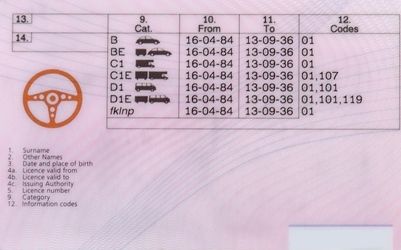
Pre January 1997 photocard licence
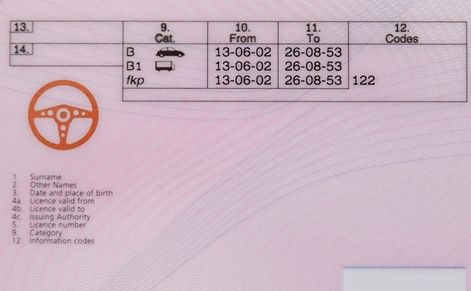
Post 1 January 1997 photocard licence with limited entitlements
Driving licence entitlements gained from a car driving test passed before 1 January 1997
Your car driving licence will show categories which include: B, BE, C1, C1E(107). If you last updated your licence before 2013 you will need to refer to DVLA website for the meaning of the categories.
The standard UK driving licence for those who passed their test before 1 January 1997 includes both B and BE categories, entitling you to drive a vehicle with a MAM up to 3,500kg and tow a trailer up to the towing limit of the vehicle, assuming the trailer does not exceed specified dimensions.
It also includes C1 with C1E, meaning you can drive a vehicle with MAM up to 7,500kg and tow a caravan/trailer where the combined MAM of tow vehicle and trailer does not exceed 8,250kg, as long as the trailer MAM does not exceed the unladen weight of the vehicle.
There is a restriction on the C1E category, which appears as C1E(107) on a photocard licence. This means you do not have the full current C1E entitlements, you are restricted to a combined MAM of 8,250kg. To receive the full C1E entitlement, allowing you to drive vehicles with a combined MAM of 12,000kg)you will need to pass a further driving test.
For the majority of people, these entitlements enable a full range of camping units to be used, unless you want to use a large tow vehicle and trailer that would push the combined MAM over the 8,250kg limit or a larger American-RV-type motorhome with MAM in excess of 7,500kg.
Driving licence entitlements gained from a car driving test passed after 1 January 1997
If you passed your driving test in the UK after 1 January 1997 you will not have the C1 category on your licence, meaning you can only drive vehicles with a MAM of 3,500kg. Larger motorhomes often have an MAM above this, so you will need to take an extra driving test to gain the C1 entitlement if you want to drive such a vehicle.
Up to 15 December 2021 drivers with a standard UK driving licence were more restricted on what they could tow than drivers who had passed their test in 1996 or before. From 16 December 2021, however, all drivers who passed their standard UK driving test in England, Scotland or Wales will have both B and BE categories on their licence, entitling them to drive a vehicle with a MAM up to 3,500kg and tow a trailer up to the towing limit of the vehicle, assuming the trailer does not exceed specified dimensions.
Those who have a post-1996 driving licence can view this change on the DVLA website but the photocard licence will only be updated when it is reissued.
Note - If you intend to drive in Northern Ireland or Europe and will be driving with a larger car and caravan combination (beyond the B-only combination limit of 3,500kg) we strongly recommend you request an updated photocard driving licence well before your journey so it is immediately obvious you have the BE category entitlement.
Driving licence definition changes 19 January 2013
Entitlements are as for the driving licence gained after 19 January 2013 there is now no longer a requirement to ensure the trailer MAM does not to exceed the unladen weight of the tow car, however you are still required to ensure it's within the towing vehicle limits. Other changes included the renewal frequency changed and the plated weight of the trailer was capped at 3,500kg MAM for BE entitlement gained after this date.
If you are less experienced at towing the challenge is to find a car and caravan combination that is heavy and powerful enough to be practical while being light enough to not overburden you or the towing vehicle. We highly recommend you start small and attend a towing course to give you the required skills to tow safely, which may also give you a discount on insurance premiums.
For drivers with category B licences gained after 1 January 1997 and upgraded to BE from the 16 December 2021
- A car or motorhome with a maximum towing capacity of 2,000kg, a MAM of 3,500kg coupled with a trailer with a MAM of 1,900kg complies with the licence requirements because:
- The MAM of the trailer is within the tow capacity of the vehicle (2,000 v 1,900)
- The vehicle MAM is 3,500kg
- The total combined weight is below 7,000kg (1,900kg + 3,500kg = 5,400kg)
A vehicl but now with a heavier tow capacity of 3,500kg towing a trailer of 3,501kg could be unlawful because:
- A licence gained after 19th January 2013 is limited to 3,500kg trailer plated weight.
- The trailer is above the cars maximum towing capacity of 3,500kg (unless your B test was passed before 19th January 2013 were there is no licence limit for the trailer).
Selecting a different trailer with a lower MAM would be the easiest way to resolve this issue.
Note the weights are plated weights from the car and trailer which we understand will still apply to post 1996 licence holders.
For more information see our towing flow charts below and motorhome later, plus information at the end of this Data Sheet to aid understanding of driving licence entitlements.
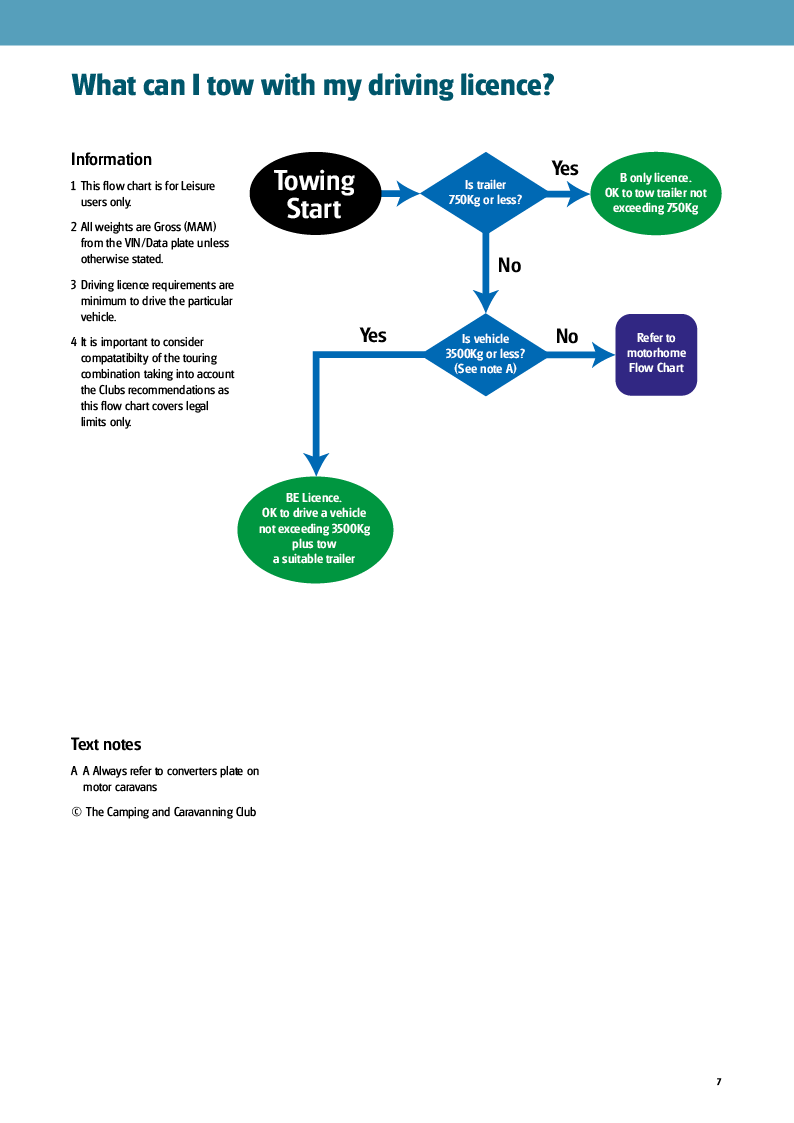
Flow chart for England, Scotland and Wales post 1996 only
Upgrading your licence entitlements
Should you wish to drive a larger vehicle such as a motorhome over 3,500kg or tow an outfit beyond your current entitlement limitations you can upgrade them by taking an additional test or tests.
For some entitlement upgrades you will need to apply for a provisional licence to practise on the road and take the appropriate test. In some cases you will also need to pass other tests for intermediated entitlements before seeking a higher category.
A standard post-1996 UK driving licence includes a provisional licence to drive category C vehicles, for example, but not to tow with a C1-class vehicle.
Upgrading for licences held before 1 January 1997
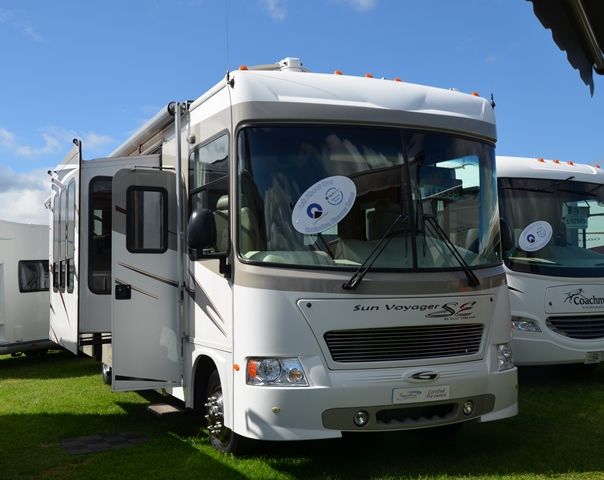
A large American style motorhome with MAM in excess of 7.5t requires a category C licence
A large motorhome with MAM in excess of 7,500kg requires a category C licence and towing outfits with a combined MAM of more than 8,250 will need C1E (C1 + E).
If you wish to tow with outfits over the 8,250kg combined MAM limit you can apply for a provisional entitlement to sub category C1E. You will then need to take a further driving test to increase your combined vehicle and trailer entitlement to a maximum of 12,000kg (tow vehicle up to 7,500kg MAM). You have to meet higher medical standards and pass both the category C theory test and the sub category C1E practical test.
To drive a larger vehicle with MAM over 7,500kg with or without a trailer up to 750kg you need to take a category C test.
Please note we strongly recommend professional tuition to increase your chances of passing the test.
Upgrading for licences gained since 1 January 1997
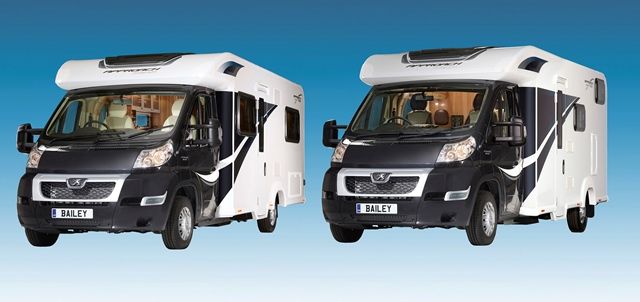
Two motorhomes of similar size, but one has a MAM of 3,500kg requiring only a category B licence and the other a MAM of 3,850kg requiring a C1 licence
Motorhome users who wish to drive vehicles with a MAM over 3,500kg may apply for provisional entitlement to the C1 category. A successful test will give entitlement to drive vehicles up to 7,500kg, with or without a trailer weighing no more than 750kg. Passing a further test to gain entitlement to C1E category will enable heavier trailers to be towed where the combined MAM of motorhome and trailer does not exceed 12,000kg.
While category BE driving licences gained after 19 January 2013 are similar to licences gained before this date and after 1 January 1997 there are some minor differences. See Driving licence definition changes 19 January 2013 (above) for more detail.
Having BE will allow motorhomes at or below 3500kg to tow trailers as long its within the train weight of the vehicle and thus the motorhome has a usable towing capability. Check the converters plate for any revised limits due to the conversion.
Refer to the flow chart below to aid understanding of the driving licence requirements for motorhome drivers
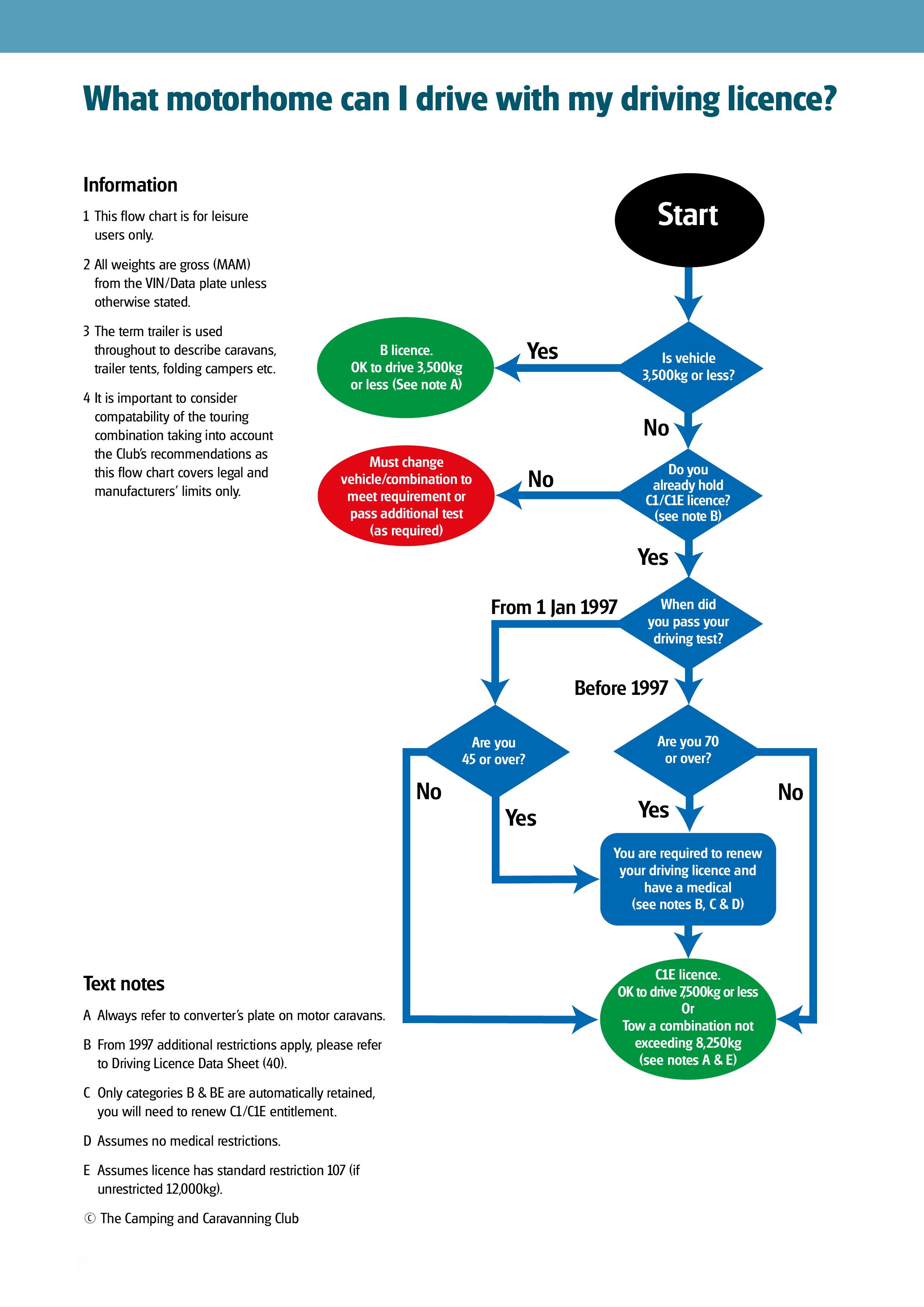
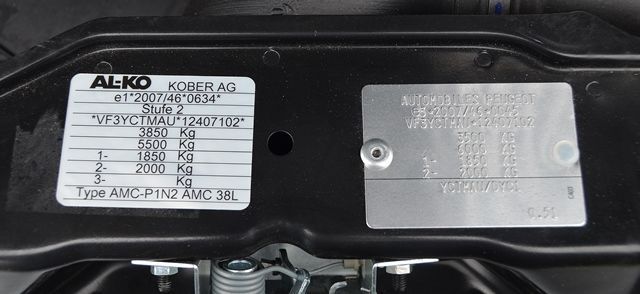
Motorhome showing multiple VIN plates with differing MAM
If a vehicle is unlikely to be used at its potential maximum weight, it may be downplated. This means a lower weight is shown on the plate or sticker attached to the vehicle than the one originally given by the manufacturer.
The process is most often undertaken by motorhome owners to reduce the MAM figure to 3,500kg to enable the vehicle to be driven on a category B part of the driving licence. This procedure needs to be registered through DVLA and should only be undertaken if you are sure the loaded weight of the motorhome can be kept within the new limit in normal use.
We strongly recommend you take your vehicle to a public weighbridge to assess your current payload to see what is possible. Use of a specialist company such as SV Tech is normally recommended to facilitate this procedure. If you exceed the new MAM figure on the road this is an offence, potentially resulting in a fine of several hundred pounds and possibly invalidating your insurance.
Similarly, motorhomes are often uprated from the base vehicle manufacturer's original figure and it is important to consider the later convertor's uprated plated weight when matching a vehicle to your driving licence entitlements.
Upgrading caravan weight
If your licence and tow car will allow it, you may be able to upgrade the weight limit of a caravan or trailer, within the physical limits of its running gear. This could give you far more capability in some instances. If this is something that you are considering, talk to the supplying dealer or SV Tech to understand the pros, cons and costs involved.
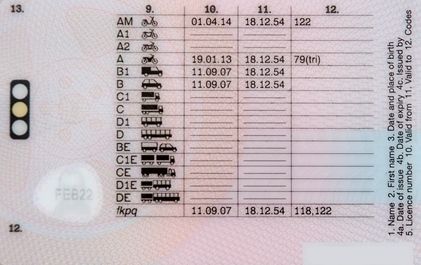
In February 2014 a new style photocard driving licence began to be issued by DVLA which contains additional security features and a new design
Car driving licences gained before 1 January 1997 are normally valid with all the entitlements including C1, C1E, D1 and D1E, until the age of 70 when they need to be renewed. However, all photocard licences have to be renewed every ten years to update the photograph.
Irrespective of previous renewals all drivers have to renew their driving licence when they reach the age of 70. Also if you change your personal details (such as your address or name) you will need to inform DVLA and it will issue a new photocard licence.
When it comes to renewal of licences there are two distinct groups of licence, car and motorbike licences (including category B and BE) known as Group 1 licences and lorry and bus licences (including categories C1, C1E, D1 and D1E) which are referred to as Group 2 licences. Group 2 licences need more frequent renewal and the higher medical standards than Group 1.
For pre 1 January 1997 licence holders, the increased frequency of renewal and higher medical standards for Group 2 licences do not come into effect until the age of 70. But for those with post 1 January 1997 licences, Group 2 licences have need to be renewed at the age of 45. From this point the Group 2 licence categories need to be renewed every five years until the age of 65 when you need to renew this element of your licence every year.
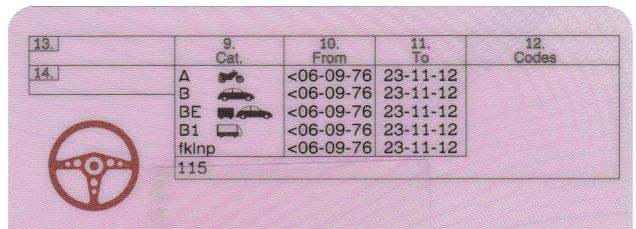
Pre 1 January 1997 licence held by driver over the age of 70 and Group 2 licence entitlements not retained
Renewal of Group 2 licences entails the submission of application form D2 and form D4 which has to be completed by a doctor and possibly an optician to check you meet the higher medical standards required for Group 2 licences. Your medical professional are likely to charge for this service.
Renewal at the age of 70 and after
Drivers who took their test before 1 January 1997
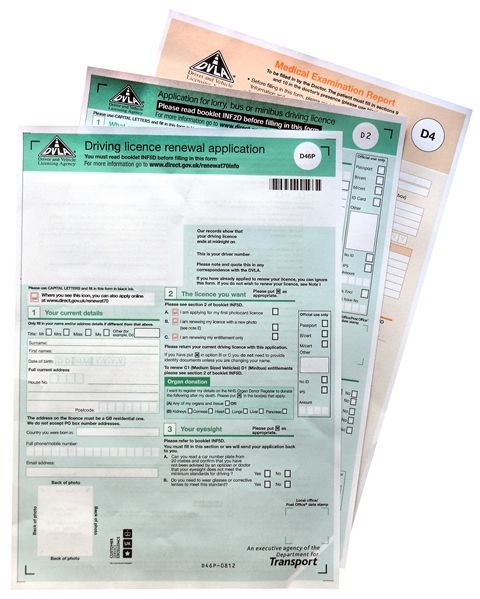
DVLA forms required to renew at 70 for pre 1 January 1997 licence holder wishing to retain their existing entitlement (sometimes known as "grandfather rights")
This renewal can be crucial to your future camping as your licence includes Group 2 categories, C1 and C1E.
If you renew online or by using just the renewal form D46P that is automatically sent with your DVLA reminder to renew 90 days before your 70th birthday you will only be able to renew your category B and BE licence (Group 1 licence categories) and not your Group 2 licence categories.
Category BE will be retained automatically, which should be sufficient for most caravan users who wish to tow with a normal car not exceeding 3,500kg MAM and tow any caravan within the car's towing limit.
However, if you wish to drive a motorhome with a MAM over 3,500kg but not exceeding 7,500kg you will also need to retain your C1 category and possibly also the C1E category to tow a trailer exceeding 750kg with such a vehicle up to a combined MAM of 8,250kg.
To retain these additional (Group 2) category rights you will need to apply by post or through the Post Office and higher medical standards apply, completing additional forms D2 and D4. Form D4 the medical examination report has to be completed by your doctor and will require a medical examination. This is ‘driver’s medical’ is classed as a private appointment by most GP practices, so you will need to pay for it.
Thereafter, your licence has to be renewed every three years and for Group 2 entitlements this means a D4 form has to accompany each renewal.
Drivers with post 1 January 1997 licences
This renewal for drivers who haven't increased their licence categories beyond Group 1 is straightforward and can be undertaken online or by using form D46P which is sent to you with your DVLA reminder to renew 90 days before your 70th birthday. If you have taken an additional test to gain BE then this can also be renewed in a similar manner without any additional medical checks.
If you have gained any Group 2 category licences (C1, C , D etc.) for medium and large vehicles then these renewals require a medical and will have been triggered at an earlier age of 45, requiring renewal every 5 years. By the age of 65 these categories will require annual renewals as distinct from the three yearly renewals prevailing for pre 1 January 1997 licence holders.
General tips for renewal of licences
- When renewing by post or at the Post Office retain a copy of your current licence showing your present entitlements as it has been known for certain entitlements to be inadvertently deleted by DVLA.
- If there are delays in DVLA processing your application you may still be able to continue driving, see DVLA INF188/6 for your rights under Section 88 of The Road Traffic Act 1988.
- When category B and BE licences are renewed it is with self-certification of medical competence. You have a duty to inform DVLA of any medical condition that may affect your driving and DVLA may issue your licence for lesser periods than normal. Full details of specific medical conditions and requirements are published by DVLA on its website.
- If you are renewing a driving licence on-line be sure to use the official website. There are several other websites which offer a check and send service, however, you can end up paying as much as three times the normal price for your driving licence.
- If you allow any Group 2 entitlements to lapse by not completing a medical they're not lost. DVLA has assured us that anyone wishing to reinstate lapsed categories such as C1 may do so but they must complete form D2 and have the medical to support the completion of form D4.
Some other restraints for safe and legal driving
- Driving licence requirements are not the only legislation you need to comply with. In particular you need to ensure you are driving and towing within the vehicle manufacturer's specification.
- There are regulations governing the dimensions of motor vehicles and trailers and these vary with the type of vehicle, hence when your driving licence restricts the class of vehicle you can drive this will also affect the size of the trailer you can tow. In particular, if you buy a caravan from outside the UK you will need to make sure it is legal for you to tow on the road.
- Ensure you do not exceed your vehicle's MAM nor individual axle weight limits - motorhome drivers need to take great care they don't overload their vehicle especially when carrying motorbikes or other heavy loads at the rear.
- Fifth-wheel owners must ensure their pick-up vehicle is adequate to take the fifth-wheel load on the back. In some cases the rear axle may need to be uprated and the vehicle replated.
- Vehicle towing limits should not be exceeded and remember vehicles will have a towing limit for unbraked trailers (which many small camping trailers are) and another limit for braked trailers.
- There are miscellaneous other matters to take into account to remain legal such as the use of towing mirrors, breakaway cables and towing brackets. The Club's Data Sheet series Safe for the Road covers these other legal matters and much more.
Even though you may be legal to tow from the perspective of your driving licence and vehicle requirements, the Club's recommendations may well suggest an adjustment to your prospective towing outfit on the grounds of safety.
When towing for the first time. The Data Sheet (20) Matching Car and Caravan provides much useful information to ensure a good match.
The Club's website has an online matching service for members known as Towsafe which can be accessed via the member log-in page at myccc.co.uk/towingmatch. Alternatively contact the Club's Technical Team on 02476 475282 or email techtalk@campingandcaravanningclub.co.uk for more advice.
It is very important that any prospective trailer, caravan or motorhome user understands the law and limitations of using such a vehicle and we strongly recommend you do a training course with a suitably approved instructor to give you the required skills to enjoy our hobby safely such as a Club manoeuvring course. These are held throughout the country and will provide you with a good grounding in towing safely and legally. Further information is available here or call the Club on 02476 475426.
This section applies to driving licences issued in Northern Ireland to B only drivers passing a test after 1st January 1997
Although much of the driving licence is the same, the devolved Government in Northern Ireland (NI) makes its own decisions on certain aspects of driving. The Driver and Vehicle Agency (DVA) has decided to keep the limits associated with a B only driving licence and require a test to gain BE. This entitlement impacts on leisure activities and though they should not stop you camping they may limit the range of leisure vehicles you can use.
Further information from NI Government is available here
Your car driving licence will permit you to drive vehicles in category B, including:
- A vehicle (including a motorhome) with a MAM not exceeding 3,500kg
- The above vehicle towing a trailer not exceeding 750kg.
- The above vehicle towing a trailer in excess of 750kg providing the combined MAM of tow vehicle and trailer does not exceed 3,500kg.
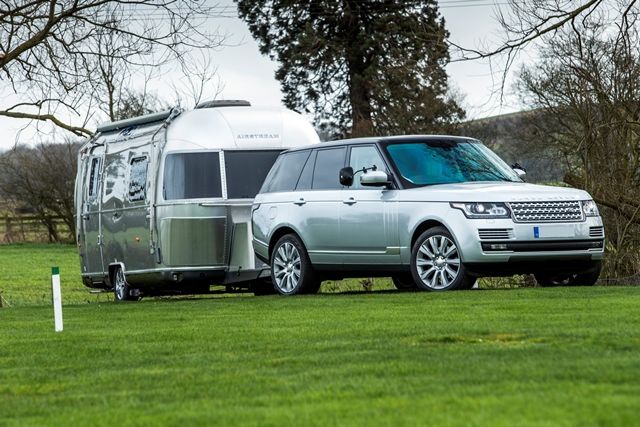
Towing a heavy caravan like the one shown here cannot be towed with a post 1 January 1997 driving licence issued in NI without taking a further test. With a category B licence a vehicle such as a Range Rover with a MAM over 2,750kg can only tow a trailer with a MAM of 750kg such as a folding camper or trailer tent.
With this category B licence you need to select both the tow vehicle and caravan carefully to maximise the weight of caravan you can tow. For example whereas a heavy, powerful tow car like a Land Rover Discovery is normally considered ideal for larger caravans because it has a MAM of around 3,200kg, a category B licence will limit you to towing a trailer not exceeding 750kg.
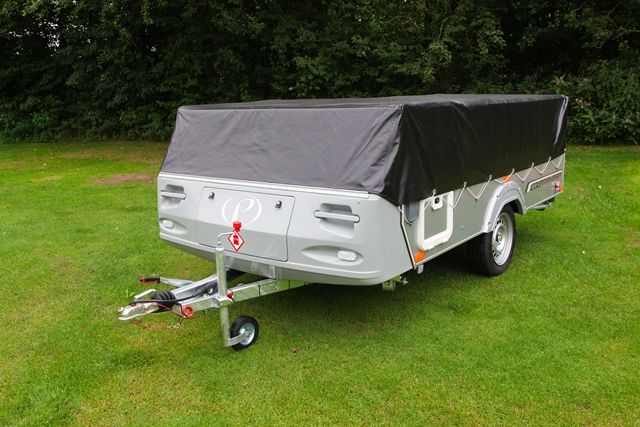
A folding camper or trailer tent is an ideal towing choice for large and small vehicles weighing around 750kg (MAM)
The secret is to find a car which is heavy enough and powerful enough to be practically competent to tow your caravan while being light enough to keep you within your licence requirements. In many cases a family saloon or estate car such as a VW Passat or Ford Mondeo will provide an excellent balance of towing competence with low enough MAM to provide for a reasonable size of caravan. To tow a caravan with a car with a combined MAM over 3,500kg you need to upgrade your licence. See "Are you Legal" below for examples of what outfits are and are not legal.
Are You Legal in Northern Ireland?
For drivers with a category B licence issued in Northern Ireland and gained after 1 January 1997
A car with a maximum towing capacity of 1,350kg, a MAM of 2,100kg coupled with a trailer with a MAM of 1,300kg complies with the licence requirements because:
The MAM of the combination (2,100 + 1,300) is 3,400kg and so does not exceed the maximum limit of 3,500kg and the cars towing limit is higher than the trailer MAM
A similar car and trailer combination to the above but now with a lower maximum towing capacity of 1,250kg could be unlawful because:
The trailer is above the cars maximum towing capacity of 1,250kg.
Selecting a different car with a higher capacity or a trailer with a lower MAM would be the easiest way to resolve this issue.
If the car is substituted with the estate version you may find the MAM increases to 2,190kg. The combined MAM is now 3,540kg. This combination will require drivers to have a BE licence entitlement to be legal.
Note -The weights are plated figures from the car and trailer which will apply to post 1996 licence holders who gained their licence in Northern Ireland.
For more information see our towing flow chart and information below to aid understanding of driving licence entitlements.
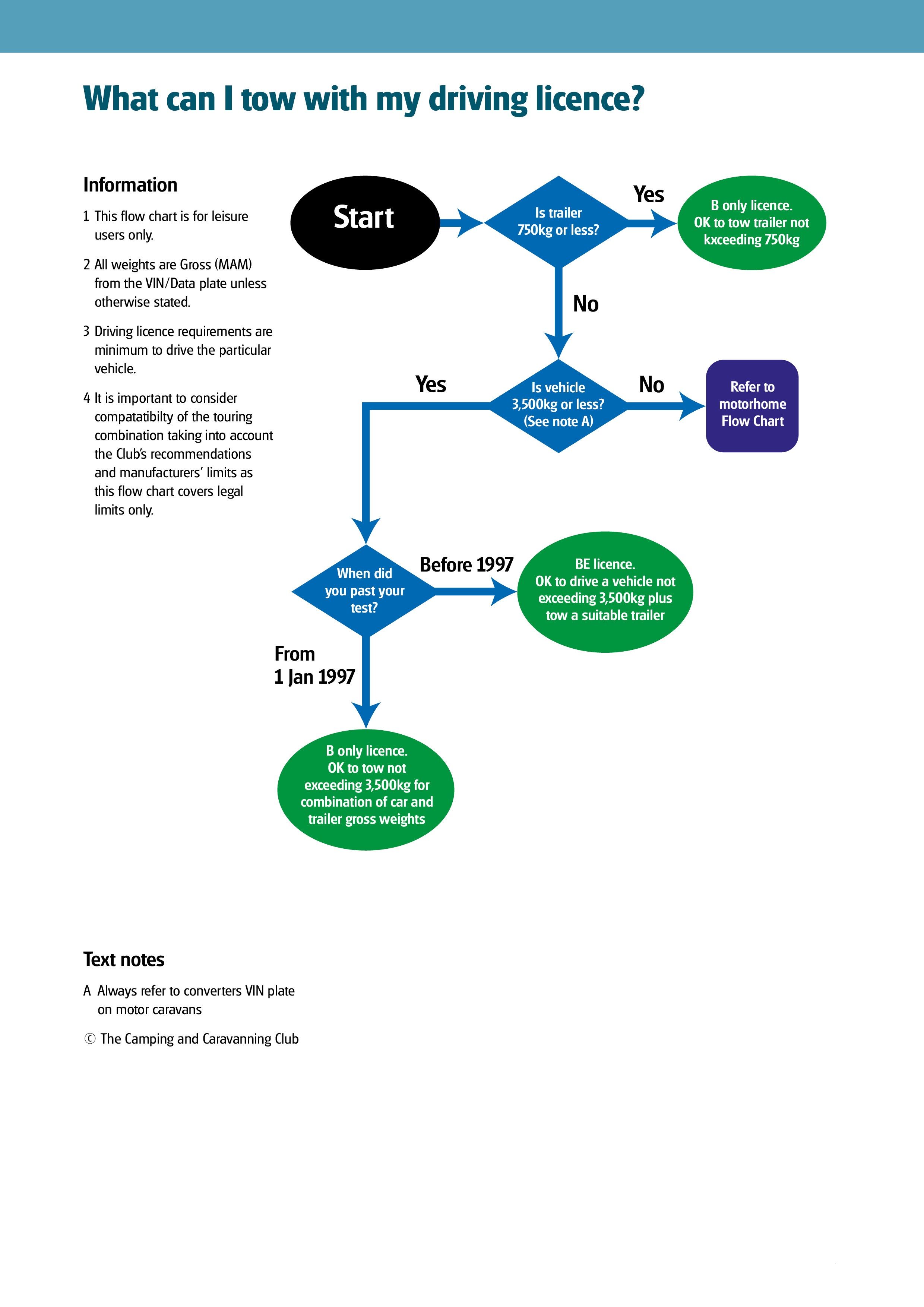
Flow chart for Northern Ireland post 1996 only
Upgrading for licences gained since 1 January 1997
A category B licence gained after 1 January 1997 comes with a provisional entitlement for BE, so you are ready to embark on a BE test. Passing this test for BE entitlement allows you to tow caravans with a category B vehicle (not exceeding 3,500kg) where the combined MAM exceeds 3,500kg.
However, you should note that this test is fairly onerous and it is generally accepted that training is needed.
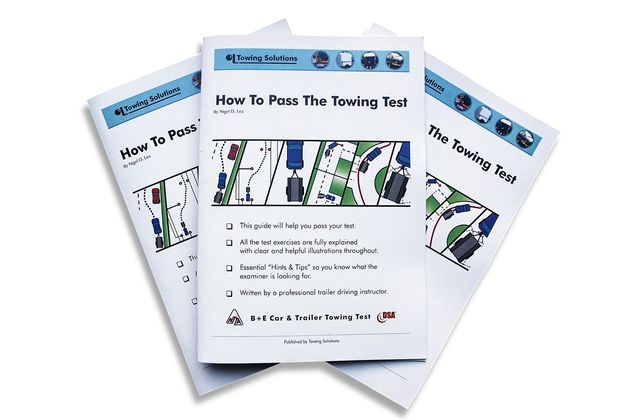
A useful booklet to guide you through the BE towing test
A useful booklet to guide you through the BE towing test professional tuition is advantageous to increase your chances of passing. For further information about the test refer to How to Pass the Towing Test, published by Towing Solutions.
It should be noted that the BE test and other upgrade tests do require a particular specification of trailer or unit in terms of weight and or size to be used during the test. Refer to NI Government website for the latest requirements.
Camping and Caravanning Club website - see the technical pages of the help and advice section: www.myccc.co.uk/technicalhelp/
Club Technical helpline for members: 02476 475282 or email techtalk@campingandcaravanningclub.co.uk
DVLA and DVSA via their website - see driving - driving licences GOV.UK
Northern Ireland Government Car and trailer tests https://www.nidirect.gov.uk/articles/car-and-trailer-practical-driving-test
How to Pass the Towing Test by Nigel Lea, published by Towing Solutions (available via amazon.co.uk)
The Club wishes to thank Barry Norris for his contribution to this Data Sheet.
If you have feedback on our new format Data Sheet, please let us know, using our short Feedback Form.